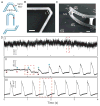Design, synthesis, and characterization of novel nanowire structures for photovoltaics and intracellular probes
- PMID: 22707797
- PMCID: PMC3374661
- DOI: 10.1351/PAC-CON-11-08-25
Design, synthesis, and characterization of novel nanowire structures for photovoltaics and intracellular probes
Abstract
Semiconductor nanowires (NWs) represent a unique system for exploring phenomena at the nanoscale and are expected to play a critical role in future electronic, optoelectronic, and miniaturized biomedical devices. Modulation of the composition and geometry of nanostructures during growth could encode information or function, and realize novel applications beyond the conventional lithographical limits. This review focuses on the fundamental science aspects of the bottom-up paradigm, which are synthesis and physical property characterization of semiconductor NWs and NW heterostructures, as well as proof-of-concept device concept demonstrations, including solar energy conversion and intracellular probes. A new NW materials synthesis is discussed and, in particular, a new "nanotectonic" approach is introduced that provides iterative control over the NW nucleation and growth for constructing 2D kinked NW superstructures. The use of radial and axial p-type/intrinsic/n-type (p-i-n) silicon NW (Si-NW) building blocks for solar cells and nanoscale power source applications is then discussed. The critical benefits of such structures and recent results are described and critically analyzed, together with some of the diverse challenges and opportunities in the near future. Finally, results are presented on several new directions, which have recently been exploited in interfacing biological systems with NW devices.
Figures







References
-
- Hu JT, Odom TW, Lieber CM. Acc Chem Res. 1999;32:435.
-
- Lieber CM. MRS Bull. 2003;28:486.
-
- Cui Y, Duan X, Huang Y, Lieber CM. In: Nanowires and Nanobelts: Materials, Properties and Devices. Wang ZL, editor. Kluwer Academic; 2003.
-
- Huang Y, Lieber CM. Pure Appl Chem. 2004;76:2051.
-
- Lauhon LJ, Gudiksen MS, Lieber CM. Philos Trans R Soc London, Ser A. 2004;362:1247. - PubMed
Grants and funding
LinkOut - more resources
Full Text Sources
